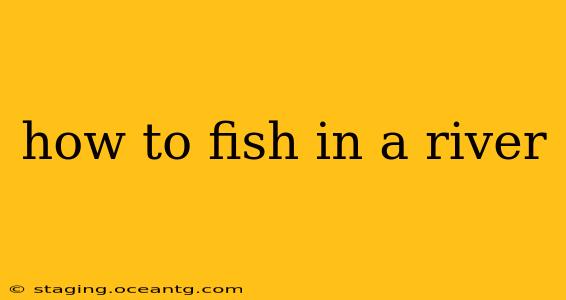Fishing in a river offers a unique and rewarding experience, different from fishing in lakes or the ocean. The current, the varying depths, and the types of fish present all contribute to the challenge and excitement. This comprehensive guide will equip you with the knowledge and techniques to successfully fish in a river, regardless of your experience level.
What Kind of Fish Can I Catch in a River?
This depends heavily on your geographical location and the specific river. Some common river fish include trout (brown, rainbow, brook), bass (largemouth, smallmouth), catfish, salmon (depending on the season and river system), and various panfish like bluegill and sunfish. Researching the specific species found in your target river is crucial for choosing the right bait and techniques. Local fishing reports and online forums are excellent resources.
What Gear Do I Need for River Fishing?
The necessary gear varies depending on the type of fish you're targeting and the river's characteristics. However, some essential items include:
- Rod and Reel: A medium-light to medium power rod with a spinning or baitcasting reel is a versatile choice for many river situations. Consider the length of the rod—longer rods offer better casting distance, while shorter rods are more maneuverable in tight spaces.
- Line: Choose a line appropriate for the type of fish and the conditions. Monofilament, fluorocarbon, and braided lines all have their advantages and disadvantages.
- Hooks: Select hooks in sizes appropriate for the bait and the fish you're targeting.
- Weights: Sinker weights help your bait reach the desired depth, especially in faster currents. Various types are available, such as split shot, bullet weights, and egg sinkers.
- Bait: This depends heavily on the target fish. Live bait like worms, minnows, and insects are effective, as are artificial lures such as spinners, spoons, and jigs.
- Waders (Optional but Recommended): Waders allow you to access deeper pools and wade comfortably in the river. Always prioritize safety and choose waders appropriate for the water temperature and conditions.
What are the Best Techniques for River Fishing?
River fishing techniques vary depending on the river's flow, structure, and the fish you are targeting. Here are a few popular methods:
- Drift Fishing: This technique involves letting your bait drift naturally with the current. It's effective for trout and other fish that hold in current seams.
- Nymphing (for Trout): This method uses weighted flies to imitate aquatic insects, allowing you to fish at various depths in the river.
- Spin Fishing: This popular method utilizes spinning lures, which are particularly effective for bass, trout, and other active river fish. Cast upstream and allow the lure to drift naturally with the current.
- Fly Fishing: Fly fishing requires specialized equipment and techniques but offers a unique and rewarding experience, particularly for trout.
- Bank Fishing vs. Wading: Bank fishing is convenient, but wading often allows you access to better fishing spots. Always prioritize safety when wading, and be aware of the river's current and potential hazards.
What are the Best Times to Fish a River?
The best time to fish a river often depends on the species you're targeting and the season. Generally, dawn and dusk are productive times, as fish are often more active during these periods of lower light. However, weather conditions also play a significant role; overcast days and periods of rain can improve fishing success.
What are Some Common Mistakes to Avoid When River Fishing?
- Ignoring the Current: Understanding the river's current is crucial for success. Position yourself to cast upstream, allowing your bait to drift naturally.
- Using the Wrong Bait: Researching the types of fish in your target river and selecting appropriate bait is critical.
- Neglecting Safety Precautions: Always prioritize safety when fishing in a river. Wear appropriate clothing, be aware of the current, and never fish alone.
How Do I Choose the Right Location to Fish in a River?
Look for areas with cover, such as overhanging trees, rocks, and undercut banks, as these are prime locations for fish to hold. Ripples, eddies, and deeper pools are also generally good spots. Observe the river and look for signs of fish activity, such as rising fish or feeding birds.
This guide provides a solid foundation for successful river fishing. Remember, practice makes perfect, and the more time you spend on the river, the better you'll become at understanding its nuances and catching fish. Always remember to practice responsible angling and respect the environment.
